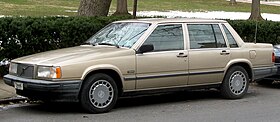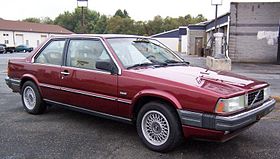Volvo 700 Series
| Volvo 700 | |
|---|---|
 |
|
| Overview | |
| Manufacturer | Volvo Cars |
| Production | 1982–1992 produced 1,430,000 |
| Assembly |
Kalmar, Sweden Clayton, Australia |
| Body and chassis | |
| Class | Mid-size luxury / Executive car (E) |
| Layout | FR layout |
| Chronology | |
| Predecessor | Volvo 200 series (which continued) |
| Successor | Volvo 900 series |
| Volvo 740 | |
|---|---|
 |
|
| Overview | |
| Production | 1984–1992 |
| Assembly |
Kalmar, Sweden (VKA) Ghent, Belgium Halifax, Canada (VHA) Melbourne, Australia |
| Body and chassis | |
| Body style | 4-door saloon 5-door estate |
| Powertrain | |
| Engine | |
| Transmission | 4-speed Volvo M46 manual, 5-speed Volvo M47 manual, 4-speed automatic |
| Dimensions | |
| Wheelbase | 2,770 mm (109.1 in) |
| Length | 4,800 mm (189.0 in) (1982–1986) 188.4 in (4,785 mm) (1987–1989) 4,850 mm (190.9 in) (1990–1991) 189.3 in (4,808 mm) (1992–1993) |
| Width | 1,750 mm (68.9 in) (1982–1986) 69.3 in (1,760 mm) (1987–1993) |
| Height | saloon: 1,410 mm (55.5 in) estate: 1,435 mm (56.5 in) |
| Curb weight | saloon: 1,315–1,404 kg (2,899–3,095 lb) estate: 1,371–1,458 kg (3,023–3,214 lb) |
| Volvo 760 | |
|---|---|

Volvo 760 GLE (facelift model)
|
|
| Overview | |
| Production | 1982–1990 |
| Assembly | Sweden: Kalmar (VKA) Australia: Clayton Belgium: Ghent Canada: Halifax (VHA) |
| Body and chassis | |
| Body style | 4-door saloon 5-door estate |
| Powertrain | |
| Engine | 2.3 L B23ET 173 hp (129 kW) turbo I4 2.3 L B230ET 182 hp (136 kW) turbo I4 2.3 L B230FT/FT+ 165/190 hp turbo I4 2.8 L B28F 130 hp (97 kW) V6 2.8 L B280E 170 hp (130 kW) V6 2.8 L B280F 147 hp (110 kW) V6 2.4 L D24TIC 115 hp (86 kW) turbodiesel I6 |
| Transmission | 5-speed manual 4-speed AW71 automatic 4-speed AW72L automatic (lockup torque converter) 4-speed ZF4HP22 automatic (lockup torque converter) |
| Dimensions | |
| Wheelbase | 2,770 mm (109 in) |
| Length | 1982–1987: 4,800 mm (190 in) 1988-1990: 188.4 in (4,790 mm) |
| Width | 1982–1987: 1,750 mm (69 in) 1988-1990: 69.3 in (1,760 mm) |
| Height | 1,410 mm (56 in) 1,435 mm (56.5 in) (estate) |
| Curb weight | 1,360–1,510 kg (3,000–3,330 lb) |
| Volvo 780 | |
|---|---|
 |
|
| Overview | |
| Production | 1986–1990 |
| Assembly | Turin, Italy |
| Designer | Bertone |
| Body and chassis | |
| Body style | 2-door coupe |
| Layout | FR layout |
| Powertrain | |
| Engine | 2.0 L B200ET turbo I4 2.0 L B204FT/GT turbo DOHC I4 2.3 L B230FT/FT+ turbo I4 2.8 L B280F V6 2.4 L D24TIC I6 turbodiesel |
| Transmission | 4-speed automatic 4-speed manual and electronics |
| Dimensions | |
| Wheelbase | 2,770 mm (109.1 in) |
| Length | 1986–1988: 4,800 mm (189.0 in) 1989–1990: 4,785 mm (188.4 in) |
| Width | 1,760 mm (69.3 in) |
| Height | 1,400 mm (55.1 in) |
| Curb weight | 1,549–1,583 kg (3,415–3,490 lb) |
| Chronology | |
| Predecessor | Volvo 262C |
| Successor | Volvo C70 |
The Volvo 700 series is a range of mid-size luxury cars produced by the Swedish manufacturer Volvo Cars from 1982 to 1992. The 700 series was introduced in 1982 with the luxurious 760, followed two years later by the lower priced 740 which capitalized on the prestige attained by the very similar 760. The 700 series was then gradually replaced, beginning in 1990, by the 900 series. The 700, designed by Jan Wilsgaard, was originally to have been a replacement for the 200 series, but production of that model continued until the early nineties. The expensive 780, a Bertone-designed coupé version, entered production in 1986 and departed without a direct successor only four years later.
The most visible differences between the 700 and the 900 series were the more rounded corners on the body of the latter, and a somewhat better-appointed interior. The 700 series came to an end in late 1992 when the last 740s were built (although they were considered to be of model year 1993). The range was then augmented and finally supplanted by the Volvo 850 in 1993, with the last of the 900s being sold in 1998.
Introduced in early 1984 (in the U.S. and Australia for the 1985 model year), nearly two years after the luxurious 760, the 740 was the lower-end version of the original 760. The 740 was intended to be a mid-size car that offered more style, performance, and luxury than the 200 series. The '4' in the middle of the Volvo model name had once signified a four-cylinder engine, but by the time of the introduction of the 740 it simply meant less luxurious equipment as four- and six-cylinder engines were fitted across the range. The 740 was available as a four-door sedan (sometimes referred to as the 744) and a five-door station wagon (also known as the 745).
Production of the 740 ceased on October 2, 1992, though the engine, transmission, chassis, and other details continued in the Volvo 940 (see below), which was essentially identical to the 740 with the exception of the rear of the sedans. For 1985, an intercooled version of the two-litre turbo engine (B200ET) was introduced for markets such as Italy, where larger engines were heavily taxed. This unit produces 160 PS (118 kW) at 5500 rpm, ten horsepower more than the preceding non-intercooled B19ET variant, enough for a claimed 200 km/h (124 mph) top speed. For 1989, a sixteen-valve version of the larger B230 engine was introduced (B234), with nearly as much peak power as the turbo version. This was Volvo's first multi-valve engine. In 1990, the 740 received a minor facelift with new, smaller, composite headlamps and 780-style tail lights. In 1991, both the 740 and the newly introduced 940 received an updated dashboard, similar in appearance to the ones found in the 760. The 740 remained mostly unchanged for the 1992 model year, and sales ended in 1993 in favour of the Volvo 940.
...
Wikipedia
